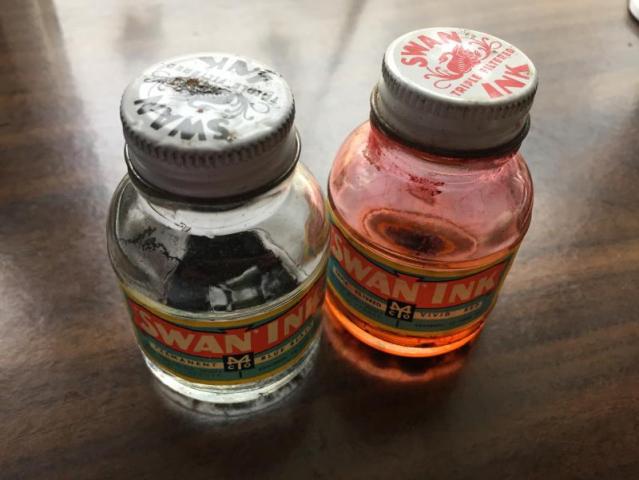Search the Community
Showing results for tags 'blue black'.
-
Rohrer and Klingner Verdigris Rohrer and Klinger – founded in 1892 in Leipzig, Germany – is a company that is mainly focusing on inks for all purposes, including fountain pen inks. Their inks come in very recognizable retro-style 50 ml bottles. R&K have produced a number of really good-looki...
- 21 replies
-
- rohrer & klingner
- verdigris
-
(and 1 more)
Tagged with:
-
I happened upon some new-old-stock bottles of "Waterman's Permanent Blue Black" ink. They were in pristine condition, and the cap sealing was good such that no ink appears to have evaporated. I see no precipitate or any other issues. The ink has a chemical scent I can't quite identify accurately,...
-

Inky T O D - Color Swatches - Blue/black - Please Post Your Pictures And Tell Us Your Thoughts
JimCouch posted a topic in Inky Thoughts
I was surprised to not find a samples topic for my favorite in color - Blue/Black. So here it is, post your Blue/Black swatches & thoughts here!- 321 replies
-
- ink
- blue black
-
(and 2 more)
Tagged with:
-
Four Ostrich iron gall blue-black inks: A Serial Review
PithyProlix posted a topic in Ink Comparisons
What’s a ‘Serial Review’? Instead of tackling a comprehensive review of four inks in one shot with the result that I’d probably never do it, I’m creating a review with smaller, bite-size chunks. I plan to add more parts of the overall review in the future, all in this thread. In future ‘episodes’ I...- 39 replies
-
- iron gall
- blue-black
- (and 4 more)
-

Büroservice Bergmann Blaufliessende Eisengallustinte (blue flowing iron gall)
yazeh posted a topic in Ink Reviews
The name is a mouthful. I discovered this ink thanks @christof. Another good ink for Iron gall ink lovers. They are made in Germany and exclusively sold by the maker Thomas Bergmann. https://www.kalligraphie-shop.com/ep...roducts/32000T They come in 2 colours: red and blue in De Atrament...- 8 replies
-
- iron gall
- water resistant ink
-
(and 2 more)
Tagged with:
-
Itty bitty, teensie weensie, low-effort review of PenBBS 391 苏 拭 (Su Shi) (pigmented)
PithyProlix posted a topic in Ink Reviews
[I did most of this as a response in another thread and I might as well make it its own topic.] PenBBS 391 苏 拭 (Su Shi) is a pigmented, dark, sort-of Prussian blue. Su Shi was a noted poet, writer, calligrapher, painter, politician, and jack of other trades, from about 1000 years ago. I...- 12 replies
-
- penbbs
- pigment ink
-
(and 1 more)
Tagged with:
-
Introduction and Elephant in the Room KWZ inks at this point don’t really need an introduction of themselves so all I can say is about page on KWZ website is the best friend here. Bottle is dark glass bottle, good for inks. Now to elephant and well there are 2 different thing...
- 29 replies
-
- kwz
- blue black
-
(and 3 more)
Tagged with:
-
Comparison of two inks with a similar teal-like color, the Noodler's ink brands itself as a Blue-Black, while J. Herbin's is called a Grey-Green. Vert de Gris is very gentle and shades very well, while Prime of the Commons can be a bit temperamental on the page, but both flow very well. Prime of the...
- 6 replies
-
- teal
- blue black
-
(and 2 more)
Tagged with:
-

Informal Review - Noodler's - Blue Steel - Dallas Pen Show 2013 - Dromgoole's
amberleadavis posted a topic in Ink Reviews
http://sheismylawyer.com/She_Thinks_In_Ink/Inklings/2013-Ink_700.jpg http://sheismylawyer.com/She_Thinks_In_Ink/Inklings/2013-Ink_701.jpg- 53 replies
-
Waterman – Blue Black I bought my very first fountain pen (a Kaweco Sport in black plastic) somewhere in 2012. Initially I just used standard royal blue ink cartridges because I didn't know any better. Sometime after that I learned on YouTube that you could syringe-fill a cartridge. That's when...
-
Calling all L’Artisan Pastellier fans, please! I am preparing an order from L'Artisan Pastellier and having trouble picking a blue-black/blue-grey. Online samples of their Callifolio blue-blacks/blue-greys can look very similar. I already have Baikal, Gris de Payne from the Classique in...
- 7 replies
-
- artisan pastellier
- callifolio
-
(and 3 more)
Tagged with:
-
Since several intriguing and passionate posts about blue black inks were posted, I thought I'll add some historical context. When steel nibs were created and soon replaced goose quills (in early XIX century), in order to deal with the corrosive nature of iron gall inks, ink makers added dyes t...
-
As far as I can tell Hero 232 Blue-Black seems to be getting scarce from my online sources. (I recently ordered a bottle Hero 232 & 233 and was sent 2 bottles of 233 instead. Then the seller promptly raised the price to over 3x what I had paid ...) Hero 202 is still readily available. I did a sear...
-
Reportedly, Private Reserve is one of the companies that paved the way to the overabundance of ink colors we have now, as early on there were mostly the basic inks available, such as basic blue-black, red, green, turquoise, brown, black, and blue. PR inks come in a multitude of different hues. The...
- 15 replies
-
- private reserve
- ebony blue
-
(and 4 more)
Tagged with:
-
Well, at long last, a review by me of an ink readily available! thanks to a sample provided by a kindly FPN member. Unfortunately, I didn't like the ink too much, perhaps I used too wet a pen. Which is surprising for me as I usually like wet inks. But I didn't find any character in the ink. As a...
- 16 replies
-
I found that pilot sells a "basic" blue black ink in massive 350ml bottles for $20 shipped on amazon with prime shipping. I couldn't find many comprehensive reviews. This might be one of the absolute best inks for professionals and students who go through ink like crazy, but want something that...
-
http://inks.pencyklopedia.pl/wp-content/uploads/Parker-Quink-Permanent-Blue-Black-old-nazwa.png Producent: Parker Series, colour: Quink Permanent Blue Black (old) Pen: Waterman Hemisphere "F" Paper: Image Volume 80 g / cm2 http://inks.pencyklopedia.pl/wp-content/uploads/buteleczki_atrament_parke...
-
I think I got this ink sample a looooonnnggg time ago, back when I was still enrolled in Ink Drop. That was before I formed my huge fondness for blue-black inks, so it sat and waited for the right time. And now, I hardcore need a bottle of this ink my life. This is a dark ink. At first you m...
- 7 replies
-
- de atramentis
- blue black
-
(and 1 more)
Tagged with:
-
This is my first real contribution to the site- please forgive any unintentional faux-pas! A friend of mine wanted to see what Pilot Blue-Black (one of my favorite inks ever!) looks like on Tomoe River paper, so I write a thing up for her to check out in person using lyrics to one of her favorite...
-
I recently went down to an antique shop and I happened to find some 'Swan' Ink bottles, made by Mabie Todd & Co in Sydney Australia. One bottle was labeled "PERMANENT BLUE BLACK" while the other was "VIVID RED". They appear to have what is most likely dried ink in them, though there is a chance that...
- 4 replies
-
- mabie todd
- swan
-
(and 8 more)
Tagged with:
-
I have an old, pre-reformulation glass bottle of Diamine Blue-Black, and a pre-reformulation glass bottle of Diamine Onyx Black. Both of these inks were purchased around 2010 and have been used periodically since then, but not very often as I don't particularly like the purple undertone of the bla...
- 9 replies
-
- diaminereformulation
- onyx
-
(and 4 more)
Tagged with:
-

Pilot Blue/black - Not Available In Bottles In The Uk - Why?
Mercian posted a topic in Inky Thoughts
Hi, I would like to buy a bottle of Pilot Blue/Black ink, because I have read many complimentary things about it on here, but... ...I live in the UK, and it seems that Pilot won’t let us British types buy it in bottles The only bottled inks that Pilot will let us buy are the 60ml bottles of Namiki...- 8 replies
-
- pilot blue/black
- blue black
-
(and 4 more)
Tagged with:
-
I know that this topic is already kind-of discussed in various places on FPN but I can't seem to find a straight answer. My question: I would like to find a nice water resistant or proof, good performance on cheaper paper blue, black or blue-black ink safe for my vintage Sheaffers (Touchdown and...
-
As I said in my previous Ferro dell'Elba / Grigio Fumo / Fading Gray ink review, Stipula Inks really impressed me. I never expected to like so much a grey and a blue-black ink. Notturno Giannutri is a greysh blue-black, with really nice shading qualities that makes it stand out among most of the...
- 6 replies
-
- stipula
- notturno giannutri
-
(and 2 more)
Tagged with:
-
Aurora inks come in three basic colors: blue, blue black and black. The bottle holds 45 ml of ink. Inks can be also bought in cartridges. For many years Aurora wasn't interested in expanding their color range. They seemed to think that Blue and Black are able to fully satisfy fountain pen afficion...


































